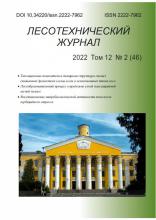The article describes the approach to a substantiation of a choice of machines systems for wood harvesting, based on simulation modeling of manufacturing processes using Petri nets. Selection of groups of sites with relatively similar conditions from the point of view of technological process of timber harvesting is justified. The results of performed field investigations, modeling and improvement of processes on the example of one model cutting area are given. Simulation results showed that under the conditions of considered cutting area average productivity of forwarder is slightly higher than possible performance of the harvester under given conditions, which leads to forced outages of forwarder, which account for about 12% of time. When modeling, distribution of forwarder' down time and allocation of its working time on the transaction is given. As a result of performed study it was recommended to replace forwarder Komatsu 890.3 by more light and economical forwarder Komatsu 860.4. Simulation performed after making the model changes, showed that in this case forwarder's down time is reduced from 12% to 8%. Taking into account lower costs of buying and maintenance of this forwarder, as well as lower fuel consumption, it was determined that in the case of proposed option, it will possible to reduce the specific costs for procurement of one cubic meter of wood 274.7 to 266.7 RUB, i.e. by 3.1%. Thus, in solution of real industrial problem, the effectiveness of the proposed approach to the assessment of options for the acquisition of systems of machines for wood harvesting has been proven.
wood harvesting, wood harvesting machinery, harvester, forwarder, simulation modeling, Petri Nets
Одной из важных задач, стоящих перед лесозаготовительными компаниями, является задача рациональной организации производственных процессов предприятия. Одним из аспектов, определяющих успешность решения этой задачи, является правильный выбор применяемых машин и оборудования [5, 10]. На выбор машин влияет целый ряд разнообразных факторов. Во-первых, это природно-производственные условия, в которых работает данное конкретное предприятие: преобладающие характеристики древостоев, почвенно-грунтовые условия, густота дорожной сети и др. Во-вторых, это производственно-технические характеристики оборудования: производительность, экономичность, экологичность, эргономичность и т. д [1, 6, 9]. Кроме того, следует учитывать эффективность работы нескольких машин разного назначения внутри комплекса: согласованность по производительности, по выполняемым функциям и т. п [3].
1. Gerasimov Y., Sokolov A., Syunev V. Development trends and future prospects of cut-to-length machinery -Advanced Materials Research. 2013, Vol. 705, pp.468-473. doi:https://doi.org/10.4028/www.scientific.net/AMR.705.468
2. Jensen K., KristensenL.M., WellsL..Coloured Petri Nets and CPN Tools for Modelling and Validation of Concurrent Systems - International Journal on SoftwareTools for Technology Transfer. 2007.Volume 9, Issue 3-4., pp. 213-254.
3. Shegelman I., Budnik P., Morozov E.Optimization of a forest harvesting set based on the Queueing Theory: Case study from Karelia. Lesn.Cas. For.J., 2015, 61,pp. 211-220. DOI: https://doi.org/10.1515/forj-2015-0029; EDN: https://elibrary.ru/WVZSJT
4. Guriev A. T., Blok A. A. Osnovy modelirovaniya raboty kompleksov lesosechnykh mashin [Fundamentals of modeling the operation of wood harvesting machines]. Izvestiya vysshikh uchebnykh zavedeny. Lesnoy zhurnal. [Bulletin of higher educational institutions. Lesnoyzhurnal]. 2004,no3,pp. 116-125(In Russian).
5. Kunickaja O.A. Aktual'nye problem lesozagotovitel'nogo proizvodstva v Rossii na rubezhe 2015 goda [Actualproblems of timber production in Russia at the turn of 2015].Aktual'nye napravlenija nauchnyh issledovanij XXI veka: teorija i praktika [Current research trends of the XXI century: Theory and Practice].2014, Vol. 2, no. 5-4 (10-4), pp.183-186.(In Russian).doi:https://doi.org/10.12737/7092
6. Makuev, V.A. Formirovanie parka lesosechnykh mashin dlya lesozagotovitel'nogo predpriyatiya [The formationof the Park, logging machinery for logging companies].Moscow, 2004, 184 p (In Russian).
7. Mammotov V. O., Mokhirev A. P. Metodika formirovaniya sistemy lesozagotovitelnykh mashin [A method for wood harvesting machines set composition]. Lesotekhnichesky zhurnal [Forestry Engineering Journal]. 2017, vol. 1, no. 1, pp. 111-117(In Russian).
8. Sukhanov Yu. V., Seliverstov A. A., Sokolov A. P., Persky S. N. Imitatsionnoe modelirovanie opertsiy trelevki forvarderom: algoritmyi realizatsiya [Simulation modeling of forwarding operations: algorithms and implementation]. Resources and Technology, 2012,Vol.9,no 1,pp. 58-61(In Russian). EDN: https://elibrary.ru/QIZPLT
9. Sushkov S. I. Razrabotka osnov teorii upravleniya iprinyatiya resheniy na predpriyatiyah lesopromyshlennogo kompleksa [Development of the foundations of the theory of management and decision-making at the enterprises of the forest complex]. Politematicheskiy setevoy elektronny nauchny zhurnal Kubanskogo gosudarstvennogo agrarnogo universiteta [Polythematic online scientific journalof Kuban State Agrarian University]. 2012,no 75,pp. 296-307(In Russian). EDN: https://elibrary.ru/OOSBZH
10. Shegel'manI.R.,Skrypnik V.I., Kuznetsov A.V. Analiz pokazateley raboty I otsenka effektivnosti lesozagotovitel'nykh mashin v razlichnykh prirodno-proizvodstvennykh usloviyakh [The performance analysis and evaluation of theeffectiveness of forest machines in different natural production conditions] Uchenye zapiski PetrGU [PetrGU's scientificnotes].2010, no.4,pp. 66-75(In Russian). EDN: https://elibrary.ru/OJLFYB











